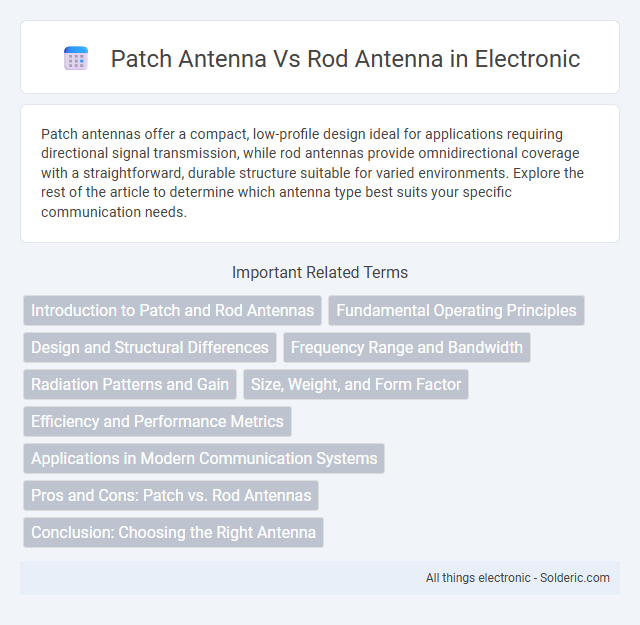Patch antennas offer a compact, low-profile design ideal for applications requiring directional signal transmission, while rod antennas provide omnidirectional coverage with a straightforward, durable structure suitable for varied environments. Explore the rest of the article to determine which antenna type best suits your specific communication needs.
Comparison Table
| Feature | Patch Antenna | Rod Antenna |
|---|---|---|
| Structure | Flat, planar metal patch on a substrate | Long, cylindrical metal rod |
| Size | Compact and low-profile | Usually longer, bulky |
| Radiation Pattern | Directional, narrow beamwidth | Omnidirectional or simple directional |
| Frequency Range | Typically UHF to GHz (e.g., 1-10 GHz) | VHF to UHF (e.g., 30 MHz to 1 GHz) |
| Gain | Moderate gain (~5-9 dBi) | Lower gain (~2-5 dBi) |
| Polarization | Linear, circular possible | Mostly linear |
| Applications | Wireless LAN, GPS, satellite comms | Radio comms, mobile antennas |
| Advantages | Low profile, easy integration, planar | Simple design, wide bandwidth |
| Disadvantages | Narrow bandwidth, sensitive to fabrication | Large size, limited directivity |
Introduction to Patch and Rod Antennas
Patch antennas are flat, low-profile devices commonly used for wireless communication due to their compact design and ease of integration into surfaces. Rod antennas, known for their cylindrical shape, excel in applications requiring omnidirectional radiation patterns and simple construction. Understanding your specific application's frequency range and coverage needs helps determine whether a patch or rod antenna offers optimal performance.
Fundamental Operating Principles
Patch antennas operate by radiating electromagnetic waves from a flat, metallic surface mounted on a dielectric substrate, creating a resonant cavity that supports a specific frequency band. Rod antennas function based on the transmission and reception of radio waves through a thin, linear conductor, relying on standing wave patterns formed along their length for effective radiation. Your choice depends on the desired frequency range, size constraints, and radiation pattern, as patch antennas offer compact planar designs while rod antennas provide omnidirectional coverage.
Design and Structural Differences
Patch antennas feature a flat, rectangular or circular metallic patch mounted on a dielectric substrate above a ground plane, offering a low-profile, planar design ideal for compact wireless devices. Rod antennas consist of a single, elongated conductive element, typically a metal rod, which functions as a resonant element with a simple, linear structure often used in VHF and UHF applications. The patch antenna's design supports surface wave propagation and allows for easier integration into printed circuit boards, while the rod antenna's linear geometry promotes omnidirectional radiation patterns with straightforward manufacturing.
Frequency Range and Bandwidth
Patch antennas typically operate within a narrow frequency range and offer limited bandwidth, making them ideal for applications requiring precise frequency control such as GPS and Wi-Fi. Rod antennas, on the other hand, provide a wider frequency range and broader bandwidth, supporting versatile uses like HF and VHF communication systems. Your choice between patch and rod antennas depends on the specific frequency and bandwidth requirements of your wireless application.
Radiation Patterns and Gain
Patch antennas exhibit a broadside radiation pattern with moderate gain typically ranging from 6 to 9 dBi, making them suitable for directional applications where a consistent coverage area is needed. Rod antennas, commonly used as monopoles, provide an omnidirectional radiation pattern with lower gain around 2 to 5 dBi, ideal for uniform signal distribution in all horizontal directions. Your antenna choice depends on whether you require focused energy for longer range or uniform coverage for varied orientations.
Size, Weight, and Form Factor
Patch antennas are compact and lightweight with a low-profile, flat form factor ideal for space-constrained applications. Rod antennas tend to be longer and bulkier, adding weight and requiring more installation space. The slim, planar design of patch antennas enables easier integration into portable and aerodynamically sensitive devices compared to the more protruding structure of rod antennas.
Efficiency and Performance Metrics
Patch antennas typically offer higher efficiency and better performance metrics such as gain and bandwidth compared to rod antennas due to their planar structure and ability to support multiple resonant modes. Rod antennas, while simple and compact, usually exhibit lower radiation efficiency and narrower bandwidth caused by their limited surface current distribution. Enhancing your system's performance may benefit from choosing a patch antenna when efficiency and gain are critical factors.
Applications in Modern Communication Systems
Patch antennas are widely utilized in modern communication systems such as satellite communication, GPS devices, and cellular networks due to their low profile, ease of fabrication, and integration with printed circuit boards. Rod antennas, typically employed in VHF and UHF applications, provide omnidirectional radiation patterns ideal for mobile and radio communication systems requiring broad coverage. Both antenna types serve critical roles in wireless communication infrastructure, with patch antennas favored for compact, high-frequency uses and rod antennas preferred for simplicity and effective long-range transmission.
Pros and Cons: Patch vs. Rod Antennas
Patch antennas offer a low-profile, lightweight design ideal for compact wireless devices, providing consistent directional radiation patterns with moderate gain. However, they typically exhibit narrow bandwidth and lower efficiency compared to rod antennas, which deliver omnidirectional coverage with higher gain and broader bandwidth suitable for long-range communication. Rod antennas tend to be bulkier and more susceptible to physical damage, making them less favorable for portable or space-constrained applications.
Conclusion: Choosing the Right Antenna
Patch antennas offer compact, low-profile designs ideal for applications requiring integration into flat surfaces, while rod antennas provide omnidirectional coverage and greater range in open environments. Your choice depends on whether size constraints and aesthetic integration or signal reach and coverage priority take precedence in your project. Consider factors like installation space, frequency range, and directional needs to select the antenna that best matches your communication requirements.
patch antenna vs rod antenna Infographic

 solderic.com
solderic.com